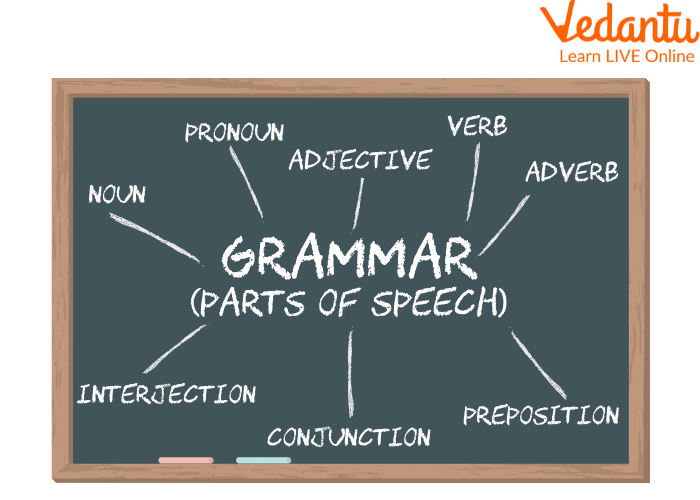




Introduction to Class 5 English Grammar
Grammar is called the system and structure of a language. The rules of grammar let us decide the order we put words in and which form of a word to use.
In this article, we will discuss the basics of English Grammar, like how a sentence forms, the rules for writing a grammatically correct sentence, transitive verb and intransitive verb, active voice and passive voice with their sentence structure, and noun and its types. Parents should refer to the English Grammar for Class 5 PDF for details on every topic.

All Parts of Speech
Class 5 English Grammar - The Sentence
When we write or speak, we try to group sensible words to convey a clear, meaningful message. In fact, grouping is not sufficient; these words need to be in proper order and sequence for clear understanding. Words arranged in order should express a complete sense of meaning.
Read the following sentences:
Useful is a spoon utensil.
A spoon is a useful utensil.
Are they different?
Rules to Make a Sentence
A sentence is a group of words forming a meaningful message.
A sentence always makes clear sense.
A sentence always starts with a capital letter and ends with a full stop, question mark, or exclamation mark.
A sentence must consist of a word i.e. verb.
Now read these Group of Words:
In the glass.
A glass of milk.
The above words make sense but not completely. These groups of words are called phrases.
Kind of Sentences
Sentences are of four types:
Assertive Sentences
Imperative Sentences
Interrogative Sentences
Exclamatory Sentences
1. Assertive Sentences - These are also called declarative sentences, which declare a fact. They end with a full stop.
Examples:
I'm going to play.
2. Imperative Sentences - These sentences give a command, make requests or express a wish.
Examples:
Go to your office. (Order)
Please lend me your book. (Request)
Have a safe ride. (wish)
3. Interrogative Sentences - These sentences are used to ask questions. They end with a question mark.
Examples:
Who has broken my pencil?
4. Exclamatory Sentences - These sentences express sudden or strong feelings such as wonder, surprise, wonder, happiness, etc. They often end with an exclamatory mark.
Examples:
That was ridiculous!
Active and Passive Voice
Sentences can be of two types: active and passive voice.
Ram is eating a mango.
A mango is being eaten by Ram.
What’s the difference between them?
In sentence 1, the subject (Ram) is the doer of the action i.e. the subject of the verb acts or is active. The verb, eating is, therefore, said to be in the Active voice.
Structure: Subject + verb + object.
In sentence 2, the subject (mango) is the receiver of the action. Here, the subject of the verb does not perform the action or is passive.
Structure: Object + verb + subject.

Girl Depicting Parts of Grammar
Verb - Transitive or Intransitive
The verb is a part of speech that depicts action. It tells what is happening or what is done at the moment.
Transitive Verb
The lion was killed.
This sentence doesn’t make complete sense.
The lion killed a deer.
So, here it makes sense, the verb which requires an object after it is called the transitive verb.
Intransitive Verb
The tree grows.
It makes complete sense. Here the verb “grows” doesn’t require any object after it to make a meaningful sentence.
Noun
The noun is a reference to a place, person, or thing. When this is one, they are called singular nouns, and when they are multiple, they are called plural nouns.
For example- boy, pen, a copy is singular nouns, and boys, pens, and copies are plural nouns.
Class 5 English Grammar Worksheets with Answers
He _____ never forgotten his bottle. (Ans. has)
I ______ played cricket. (Ans. have)
Convert into passive voice: Rahul is playing cricket. (Ans. Cricket is being played by Rahul)
Write five plural nouns. (Ans. Books, Pencils, Bottles, Boxes, Cups)
Write one interrogative sentence. (Ans. How was your day?)
Summary
In this article containing English Grammar for Class 5 PDF, we discussed the sentences, verbs, voice, and nouns, which are basics of English Grammar. The given worksheet will help you to identify the types of questions related to grammar with their answers provided. A sentence is a complete sense, made up of words arranged in an order to convey a meaning, or thought.
The basic rules of making a sentence are:
The sentence should begin with a capital letter and end with a full stop.
A sentence must consist of a doing word i.e. verbs.
The words should be arranged in order to convey a clear meaning i.e. sentence structure.
FAQs on Class 5 English Grammar: Key Grammar Concepts for Class 5 Students
1. What are the 5 rules of grammar?
Punctuation- Punctuation in written English is used to indicate pauses, tone, stressed words, commas, and operators.
Tense- By adding constraints to verbs, tenses indicate whether a statement belongs to the present, the past, or the future.
Determiners- Nouns rarely stand on their own without a supporting clause, they require determiners like "which," "how many," "what," "my," and so on to convey meaning.
Connectors- Connectors are words, phrases, or clauses that are "connected" to one another. Examples: (if, who, that, when, because, even though), coordination (but, and, yet, nor), or correlation (either, or, both, and).
2. Who first used English Grammar?
Greeks of Europe were the first to write grammar. Grammar was a tool that could be used in the study of Greek writing. So, their focus was on the literary language. The Alexandrians of the first century bc further created Greek Grammar to save the purity of the language.
3. How did the grammar of the Greeks go through several stages?
Grammar can be divided into several stages: preliminary, intermediate, and advanced. The first stage was aimed at students who have been learning to read and write. The second stage was aimed at students who have already mastered reading. The third stage was aimed at students who were learning how to write.
4. What do you mean by grammatical conjunctions?
Grammatical conjunctions are a type of word in English that connects two different clauses. It joins ideas, sentences, and even more complex thoughts in a sentence.









